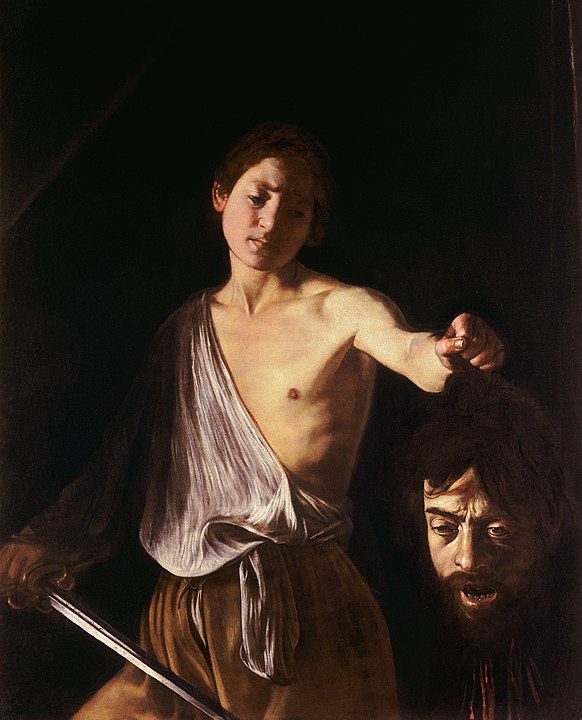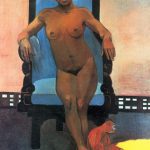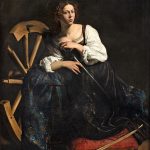
When we think of history’s greatest artists, we often imagine figures consumed by beauty and creation, laboring to craft the masterpieces we still admire today. But here’s a dark secret: many of these artists led lives that were anything but beautiful. Behind the scenes, their lives were full of chaos, violence, and scandal—often to a monstrous degree.
The myth of the “tortured artist” is more than a romantic idea; for many, it was reality. These artists left not only magnificent works of art but also trails of destruction in their personal lives. So, can we still admire their art once we understand the truth about who they really were? Buckle up as we dive into the messy, dark lives of some of art history’s most famous figures.
Caravaggio: Barroom Brawler or Cold-Blooded Killer?
Michelangelo Merisi da Caravaggio, known simply as Caravaggio, is hailed as one of the greatest painters of the Baroque period. His revolutionary use of light and shadow—known as chiaroscuro—brought intense realism to biblical and mythological scenes. But the intensity seen in his art paled in comparison to his volatile and violent personality.
Caravaggio’s early life in Rome was full of promise. He was commissioned by high-ranking church officials and aristocrats, producing some of his most famous works, such as The Calling of St. Matthew and Judith Beheading Holofernes. These paintings showcased his talent for capturing raw human emotion and drama. However, his personal life was far less controlled.
Known for his quick temper and tendency to engage in fights, Caravaggio lived a life of lawlessness. He was arrested multiple times for violent offenses, including carrying illegal weapons. The most infamous of his many clashes with the law occurred in 1606, when Caravaggio killed a man named Ranuccio Tomassoni during a brawl. The fight reportedly started over a disagreement during a tennis match, but it ended in bloodshed. Fearing the death penalty, Caravaggio fled Rome and spent the next several years on the run, traveling between Naples, Sicily, and Malta.
Despite his criminal behavior, Caravaggio’s fame as an artist only grew. His paintings became more emotionally intense, often depicting moments of violence or extreme emotion. The shadowy, dramatic lighting in his works seemed to mirror his dark, tumultuous life. Caravaggio’s ability to infuse his scenes with such emotional intensity could very well have stemmed from his own violent tendencies.
His life ended just as dramatically as it had been lived. In 1610, at the age of 38, Caravaggio died under mysterious circumstances. Some speculate he was killed in a vendetta for his many enemies, while others believe he succumbed to illness or lead poisoning from his paints. Whatever the cause, his life was one marked by brilliance and brutality in equal measure. Can we separate the genius who painted Judith Beheading Holofernes from the man who killed in real life?
Michelangelo: A Genius with Obsession and Isolation Issues
Michelangelo Buonarroti, the genius behind David and the Sistine Chapel ceiling, is one of the most revered artists in history. His technical brilliance, especially in sculpture and painting, has shaped the trajectory of Western art. But Michelangelo’s obsession with his work led him to live a life of near-complete isolation, consumed by his craft to the detriment of his health and relationships.
Unlike Caravaggio, Michelangelo wasn’t known for violent outbursts. Instead, he was notoriously difficult to work with due to his obsessive dedication to perfection. For Michelangelo, nothing mattered more than his art, often at the cost of personal relationships and his own well-being. He isolated himself from others, rarely bathing or changing his clothes, and lived in a near-permanent state of exhaustion due to overwork.
Michelangelo was also famously reclusive, avoiding social gatherings and turning away from those who sought his company. He poured all his energy into his creations, often working through the night. His obsessive perfectionism is most evident in his work on the Sistine Chapel ceiling, a project he completed over four grueling years. He painted lying on his back for hours, pushing his body to its limits.
But Michelangelo wasn’t just tough on himself—he could be harsh toward those around him as well. His relationship with fellow artists and patrons was often strained because of his exacting standards. He refused to compromise on his vision, clashing with patrons who expected more control over their commissions. His disdain for mediocrity extended to those working under him, making him notoriously hard to work for.
In his pursuit of artistic greatness, Michelangelo created some of the most iconic works in art history. Yet, his obsessive nature also left him isolated, detached from the world around him. The question remains: Can we admire his unparalleled dedication without acknowledging the toll it took on him and those around him?
Paul Gauguin: Escaping Civilization or Exploiting It?
Paul Gauguin is often seen as a pioneer of Post-Impressionism, known for his bold use of color and his depictions of life in French Polynesia. But his personal life reveals a man driven by selfish desires, who exploited others in pursuit of his idealized vision of “primitive” life. His actions, particularly in Tahiti, have left a lasting stain on his legacy.
Gauguin left behind his life in France in 1891, seeking to escape the confines of Western civilization. He settled in Tahiti, where he immersed himself in what he viewed as an untouched, “primitive” culture. His art during this time reflects this idealization, with vibrant, dreamlike depictions of Tahitian life in works like Where Do We Come From? What Are We? Where Are We Going?.
However, the reality of Gauguin’s life in Tahiti was far from the paradise he portrayed in his paintings. Upon arrival, Gauguin took advantage of the local population, engaging in relationships with girls as young as 13. His time in Tahiti was marked by the exploitation of young women, as well as a lifestyle of indulgence and irresponsibility. Despite portraying himself as a man rejecting Western norms, Gauguin sent paintings back to Europe for sale, maintaining ties with the art market he claimed to despise.
Gauguin’s portrayal of Tahiti as a pure, untouched land was far from accurate. By the time he arrived, Tahiti had been colonized by France for decades, and its culture had already been shaped by Western influence. Yet, Gauguin continued to perpetuate the myth of the “noble savage” in his work, glossing over the impacts of colonialism while benefiting from it.
Today, Gauguin’s legacy is hotly debated. His paintings remain influential, admired for their color and composition. But can we separate the artist who idealized and exploited a colonized culture from the stunning works he left behind? His actions in life raise uncomfortable questions about the morality of celebrating his art.
Edgar Degas: A Genius with Deep Prejudice
Edgar Degas is synonymous with Impressionism, his iconic paintings and pastels capturing the delicate grace of ballet dancers, horse races, and Parisian life. But Degas, despite his artistic brilliance, harbored deep anti-Semitic views that have left a troubling mark on his legacy.
The Dreyfus Affair, a political scandal in 1890s France, exposed the depth of Degas’ prejudice. At the heart of the scandal was Alfred Dreyfus, a Jewish French army officer falsely accused of treason. The affair divided France, with many, including Degas, siding against Dreyfus in an openly anti-Semitic campaign. Degas’ anti-Semitism wasn’t hidden—it caused him to sever relationships with Jewish friends, including fellow artists who supported Dreyfus.
Degas’ bigotry wasn’t just a product of the times. He actively distanced himself from anyone sympathetic to Dreyfus and became increasingly isolated as a result. His artistic career continued to thrive, but his personal relationships deteriorated. His prejudice even led him to avoid exhibiting alongside other Impressionists, as many of them supported Dreyfus.
This dark side of Degas complicates his legacy as one of the greatest painters of the 19th century. His exquisite depictions of dancers, such as The Dance Class, remain beloved, but his open hostility toward Jews is difficult to overlook. In an era when we are re-evaluating historical figures through a modern lens, Degas’ bigotry stands as a stark reminder of the moral flaws of even the greatest talents.
Can we look at The Dance Class and not think of the artist’s exclusionary views? The debate over whether we can separate Degas’ art from his prejudices continues. And it forces us to ask uncomfortable questions about the intersection of genius and morality.
Diego Rivera: Champion of the Working Class or Communist Sympathizer?
Diego Rivera, Mexico’s most famous muralist, is known for his monumental works that depict the struggles of the working class and the beauty of Mexican culture. His murals, like Man at the Crossroads and Detroit Industry Murals, tell stories of social justice, indigenous heritage, and industrialization. But behind the paint, Rivera’s unwavering support for communism—despite its repressive realities—complicates his legacy.
Rivera’s commitment to communism was central to his identity as an artist. His murals weren’t just art; they were political statements. A member of the Mexican Communist Party, Rivera believed in the fight against capitalist oppression and depicted Marxist ideals in his work. He viewed the Soviet Union as a model for the future and infused his murals with imagery that celebrated the working class and vilified the bourgeoisie.
In 1933, Rivera sparked controversy when he included a portrait of Vladimir Lenin in his mural Man at the Crossroads, which had been commissioned for the Rockefeller Center in New York. When the Rockefeller family demanded that he remove Lenin from the mural, Rivera refused. The mural was ultimately destroyed. This bold defiance solidified Rivera’s reputation as a revolutionary artist willing to risk his career for his beliefs.
However, Rivera’s devotion to communism wasn’t without flaws. While he celebrated the ideals of equality and justice, he ignored the brutal realities of Stalinist repression. Even after becoming disillusioned with Stalin later in life, Rivera never fully abandoned his communist ideals. His relationship with Leon Trotsky, whom he briefly sheltered in Mexico, adds yet another layer of complexity to his political affiliations.
Rivera’s personal life mirrored his contradictions. Despite his communist ideals, he lived lavishly, funded by wealthy patrons. His marriage to Frida Kahlo was tumultuous, filled with affairs and betrayal, including a notorious affair with Kahlo’s sister. Rivera’s political and personal choices often contradicted the very ideals he championed, leading to questions about his sincerity.
Rivera’s murals remain some of the most iconic pieces of public art in the world. But can we fully appreciate his artistic contributions without grappling with the political and personal contradictions that shaped his life? Rivera’s legacy, like his murals, is larger than life—and filled with both beauty and moral complexity.
Can We Separate the Art from the Artist?
As we reflect on the lives of these artistic giants, one question continues to loom: Can we separate the art from the artist? Caravaggio’s violent outbursts, Michelangelo’s obsessive isolation, Gauguin’s exploitation, Degas’ prejudice, and Rivera’s communist sympathies all challenge our understanding of what it means to admire an artist’s work.
The ongoing debate about whether we can—or should—separate an artist’s personal life from their creations is nothing new. In an era of “cancel culture,” we are constantly re-evaluating historical figures, particularly those whose actions or views don’t align with modern values. Some argue that we can appreciate art for its beauty and historical importance without condoning the artist’s behavior. Others insist that an artist’s personal failings should color how we view their work.
So, where do we draw the line? Can we admire Caravaggio’s breathtaking use of light and shadow without acknowledging the man’s violent temper? Can we celebrate Michelangelo’s masterpieces while recognizing the toll his obsession took on his relationships? Can we enjoy Degas’ graceful depictions of ballet dancers while being fully aware of his hateful prejudices? These questions are difficult to answer, and perhaps there is no simple solution.
In the end, the relationship between an artist and their art is as complex as the human condition itself. To view their work without acknowledging the full picture of their lives is to only understand part of the story. As viewers, it is our responsibility to engage with both the beauty and the darkness that these artists brought into the world.
As the writer James Baldwin once said, “The purpose of art is to lay bare the questions that have been hidden by the answers.” Perhaps the lives of these artists are one such question—can we bear to love the art if we know the darkness of the artist?




